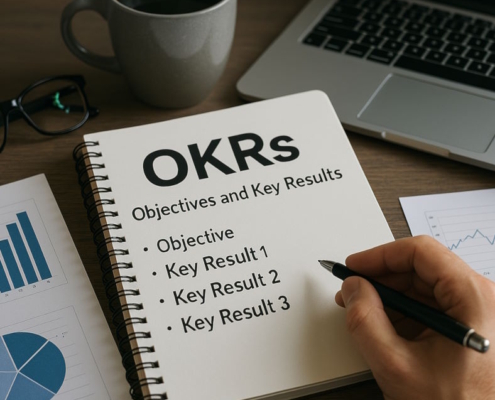Introduction
The number of workers employed in a particular occupation or position for a given period of time is commonly expressed as the job outlook. Job searchers can learn a number of key things about an occupation by researching its job outlook, such as whether or not it will grow in the coming years and whether or not there will be a good supply of jobs in that field. This post discusses in detail the answer to the question “What does job outlook mean?”, how to evaluate job outlook data, why it’s crucial to check into job outlook when looking for a job, and how it’s defined.
What does job outlook mean?
The short answer to the question “What does job outlook mean?” is that it’s the prognosis of the expected change in a specific occupation. The number of persons predicted to work in a certain profession over the course of time, like five or ten years, is typically used to estimate this data. BLS (Bureau of Labor Statistics), a division of the United States. Department of Labor projects the employment picture in the country. For numerous jobs in the United States, they offer information and insights on whether and to what extent the job outlook will improve. The Occupational Outlook Handbook produced by the Bureau of Labor Statistics updates and publishes this data every 2 years.
What can you learn from a job outlook?
A position’s job outlook indicates how much growth is expected in that position over the next several years. The BLS’s prediction of the degree of growth/decline in an occupation determines how different job outlooks are in the Occupational Outlook Handbook. When providing customers with information about job outlook, the BLS utilizes the following standards:
- Decline: This indicates that there will be a 1% or greater expected drop in jobs for this profession.
- Little to no change: This indicates that there won’t be much of an expected shift in jobs for this profession.
- Grow slower than the average: This indicates a 1%–2% rise in jobs for this profession is anticipated.
- Grow at a rate comparable to the average: This indicates that a 3%–4% rise in jobs is anticipated for this profession.
- Grow faster than average: This indicates a 5%–7% growth in jobs for this profession is anticipated.
- Grow significantly faster than the average: This indicates that an 8% or greater rise in jobs for this occupation is anticipated.
You will be able to observe the projected growth of the job/profession you are keen to pursue in the next five to ten years, based on the criteria allocated to it.
A business attorney can help businesses understand the job outlook by advising on employment laws and strategies to adapt to changing labor market trends.
Why is it crucial to consider job outlook when looking for work?
A key element of guaranteeing job security is considering the employment prospects while selecting which new role to pursue. You are more likely to find and hold a job in that domain/field if its job outlook is positive.
Regarding the career you are interested in, job outlook can provide you with a number of additional crucial details. Among these are the following:
- When your education/training is completed, how probable is it that you will find employment?
- If education and training are easily accessible for that job role
- To what extent that role will have room for advancement in the future
- How long will it take for that job position to become available?
- How promising a career outlook is for the job position in a particular area
Even if you’re considering changing careers, it is helpful to know the employment forecast for your present position. You might wish to start down the route toward an alternative career if you discover that the job prospects for your present position are predicted to decline.
How to analyze statistics on the job outlook
It’s crucial to base your interpretation of the BLS’s job outlook statistics on the explanations it provides. For instance, the BLS estimates that the employment forecast for plumbers is 5%, which indicates that the occupation is predicted to increase faster than the average. This is relevant information if you are seeking the job outlook for plumbers. Assuming a 1% growth rate for the job outlook, plumber roles are likely to rise at a lesser rate than the average growth of other occupations in the United States business.
Cons of predicting job outlooks
It’s vital to research the job outlook for a position you intend to pursue, but note that job outlook statistics have some limits.
One major drawback is that job outlook data can’t tell you everything you should know to make an informed decision about whether or not you’ll be able to work in a given industry. Examining both employment prospects and job outlook is a strategy to handle this. Job prospects give you an idea of the ratio of job seekers in a given category to available positions. There could not be many real jobs available, even though the BLS predicts that employment will increase over the next few years.
Predictions on the job prospects may also be limited by the fact that they are not always entirely correct. Although economists take great care to forecast the job outlook with a high degree of accuracy and knowledge, the economy is subject to change. For instance, the employment forecast for a post may decline despite initial predictions by economists that it would rise due to an unanticipated slump in a specific industry.
Samples of employment prospects
According to the Bureau of Labor Statistics, examples of job outlooks from the Bureau of Labor Statistics include the following:
- Management analysts: Growth is expected to be 11%, or significantly faster than normal, in the years till 2029.
- Construction managers are expected to grow at a rate significantly greater than normal, by 8% in the years till 2029.
- Retail salespeople: In the years till 2029, growth is expected to be -1%, or significantly less than average.
- Elementary School Teachers: It is projected that the number of elementary school teachers will increase by 4%, or roughly average, in the years till 2029.
- Counsellors: Growth of 13% is anticipated, which is substantially faster than average, in the years till 2029.
- Attorneys: Growth is expected to be 4%, or roughly average, in the years till 2029.
- Nurses: Projected to expand at a greater rate than average, or by 7%, in the years till 2029.
Understanding “What does job outlook mean” is a crucial step in navigating the dynamic landscape of employment opportunities. By delving into the projected growth or decline of a particular occupation over the next several years, individuals can make informed decisions about their career paths. Evaluating job outlook data not only provides insights into the job market’s trajectory but also aids in predicting the availability of jobs in a chosen field. So, next time you ponder ‘what does job outlook mean’, remember it goes beyond mere statistics—it’s a powerful tool for shaping your professional journey and securing a stable and fulfilling career.






























